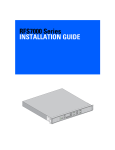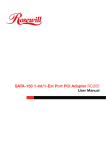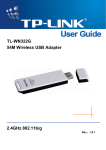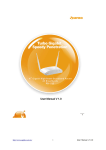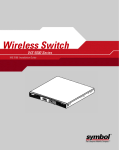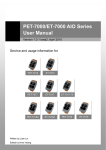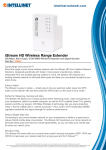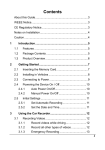Download Wireless N Adapter RNX-N250PCe User Manual
Transcript
Wireless N Adapter RNX-N250PCe User Manual Wireless N Adapter RNX-N250PCe User Manual FCC STATEMENT This equipment has been tested and found to comply with the limits for a Class B digital device, pursuant to part 15 of the FCC Rules. These limits are designed to pro-vide reasonable protection against harmful interference in a residential installation. This equipment generates, uses and can radiate radio frequency energy and, if not in-stalled and used in accordance with the instructions, may cause harmful interference to radio communications. However, there is no guarantee that interference will not occur in a particular installation. If this equipment does cause harmful interference to radio or television reception, which can be determined by turning the equipment off and on, the user is encouraged to try to correct the interference by one or more of the following measures: • Reorient or relocate the receiving antenna. • Increase the separation between the equipment and receiver. • Connect the equipment into an outlet on a circuit different from that to which the receiver is connected. • Consult the dealer or an experienced radio/ TV technician for help. This device complies with part 15 of the FCC Rules. Operation is subject to the following two conditions: 1) This device may not cause harmful interference. 2) This device must accept any interference received, including interference that may cause undesired operation. Any changes or modifications not expressly approved by the party responsible for compliance could void the user’s authority to operate the equipment. FCC RF Radiation Exposure Statement This equipment complies with FCC RF radiation exposure limits set forth for an uncontrolled environment. This device and its antenna must not be co-located or operating in conjunction with any other antenna or transmitter. “To comply with FCC RF exposure compliance requirements, this grant is applicable to only Mobile Configurations. The antennas used for this transmitter must be installed to provide a separation distance of at least 20 cm from all persons and must not be co-located or operating in conjunction with any other antenna or transmitter.” CE Mark Warning This is a class B product. In a domestic environment, this product may cause radio interference, in which case the user may be required to take adequate measures. National Restrictions 2400.0-2483.5 MHz Country Restriction Reason/remark Bulgaria France General authorization required for outdoor use and public service Outdoor use limited to 10 mW Military Radiolocation use. Refarming of the 2.4 GHz band has e.i.r.p. within the band 2454-2483.5 been ongoing in recent years to allow current relaxed regulation. MHz Full implementation planned 2012 Italy If used outside of own premises, general authorization is 2 Wireless N Adapter RNX-N250PCe User Manual required Luxembourg General authorization required for network and service supply(not for spectrum) Norway Implemented This subsection does not apply for the geographical area within a radius of 20 km from the centre of Ny-Ålesund Russian Only for indoor applications Federation Note: Please don’t use the product outdoors in France. 3 Wireless N Adapter RNX-N250PCe User Manual Table of Content Table of Content...............................................................................................4 Chapter 1 Overview .........................................................................................5 Package Content ......................................................................................5 1.1 Overview of the Product.................................................................5 1.2 Features.........................................................................................6 1.3 System Requirement......................................................................6 1.4 Specification...................................................................................6 Chapter 2 Installation Guide ............................................................................8 2.1 Hardware Installation .....................................................................8 2.2 Software Installation.......................................................................9 Chapter 3 Wireless Connection Guide...........................................................13 3.1. Connecting with Microsoft Zero Configuration tool (Win XP) .......13 3.2. Connecting with Window 7...........................................................14 3.3. Connecting with Wireless LAN Utility ...........................................15 Chapter 4 Utility Configuration – Win XP’s Station Mode............................... 20 4.1. General ........................................................................................ 20 4.2. Profile........................................................................................... 21 4.2.1 Add ......................................................................................... 21 4.2.2 Remove .................................................................................. 23 4.2.3 Edit ......................................................................................... 23 4.2.4 Duplicate................................................................................. 24 4.2.5 Set default .............................................................................. 25 4.3. Available Network ........................................................................ 26 4.4. Status........................................................................................... 27 4.5. Statistics....................................................................................... 28 4.6. Wi-Fi Protect Setup...................................................................... 29 4.6.1 Method 1 PIN Input Config (PIN) ............................................ 29 4.6.2 Method 2 Push Button ............................................................ 31 FAQ................................................................................................................ 33 Glossary......................................................................................................... 34 4 Wireless N Adapter RNX-N250PCe User Manual Chapter 1 Overview Thank you for choosing Rosewill’s 802.11n 2T2R Wireless PCI-Express adapter – RNX-N250PCE. RNX-N250PCE is a powerful 300Mbps Adapter for PCs without any hassle. The Adapter can be used in Ad-Hoc mode to connect directly with other cards for peer-to-peer file sharing or in Infrastructure mode to connect with a wireless access point or router for access to the Internet in your office or home network. This chapter is to introduce you more about this Wireless Adapter. 1.1 Package Content Before getting started, please verify that your package includes the following items: 1. Rosewill RNX-N250PCE Wireless N Adapter x 1 2. 5 dBi Antenna x2 3. Low Profile Bracket x1 4. Quick Installation Guide x1 5. Resource CD x1, including: z Rosewill Wireless N Utility and Driver z User Manual Note: Make sure that the package contains the above items. If any of the listed items are damaged or missing, please contact with your distributor. 1.2 Overview of the Product The adapter is an 802.11n client device; it is designed to provide a high-speed and 5 Wireless N Adapter RNX-N250PCe User Manual unrivaled wireless performance for your computer or notebook. With a faster wireless connection, you can get a better Internet experience, such as downloading, gaming, video streaming and so on. With the 802.11n technology, higher throughput improvements using MIMO (multiple input, multiple output antennas), the RNX-N250PCE’s transfer rate up to 300Mbps for maximum throughput. It can also interoperate with other wireless (802.11b, 802.11g) products. The adapter supports 64/128-bit WEP, WPA and WPA2 encryption to prevent outside intrusion and protect your personal information from being exposed. The adapter is easy to install and manage. The Quick Setup Wizard guides you step-by-step through the installation process; the Rosewill Wireless N Client Utility helps you create a wireless connection immediately. With unmatched wireless performance, reception, and security protection, the RNX-N250PCE is the best choice for easily adding or upgrading wireless connectivity to your notebook and computer. 1.3 Features z Comply with IEEE 802.11b, 802.11g and 802.11n standard for 2.4GHz Wireless LAN z Support advanced 2 x 2 MIMO Technology with up to 300Mbps data transfer rate z Support 64/128-bit WEP,WPA and WPA2 wireless security modes z Windows 7-32/64 bit, Vista 32/64 bit, XP, 2000, Linux support z Supports Sony PSP X-link for online gaming z Supports roaming between access points when configured in Infrastructure mode z Easily connect and secure your wireless network with WPS (Wi-Fi Protected Setup) 1.4 System Requirement You must have at least the following z A desktop PC with an available working PCI-Express slot z At least a 300MHz processor and 32MB of memory z Windows OS for Win98SE, ME, 2000, XP, Vista, Win7 z A CD-ROM Drive z A 802.11n 、802.11g or 802.11b Wireless Access Point/Router (for infrastructure Mode) or another 802.11n、802.11g or 802.11b wireless adapter (for Ad-Hoc; Peer-to-Peer networking mode). 1.5 Specification 6 Wireless N Adapter RNX-N250PCe Chipset User Manual Realtek RTL8192CE Standard IEEE 802.11n, IEEE 802.11g, IEEE 802.11b Interface PCI-E Interface Frequency Range 2.412 - 2.4835GHz 802.11b: up to 18 ± 1 dBm Wireless Transmit Power 802.11g: up to 14 ± 1 dBm 802.11n: up to 13 ± 1 dBm Modulation Technology OFDM/CCK Security Support 64/128 bit WEP, WPA-PSK/WPA2-PSK (TKIP and AES) Antenna 2x 5dBi detachable Directional Antenna Operating: 0°C~40°C (32℉~104℉) Temperature Storage: -20°C~70°C (-40℉~158℉) Relative: 15% ~ 95%, Non-Condensing Humidity Storage: 5% ~ 90% Non-Condensing Dimensions Weight 1.8" x 2.9" (45 x 74 mm, excluded Antenna) 0.08 lbs. (40g, excluded Antenna) 7 Wireless N Adapter RNX-N250PCe User Manual Chapter 2 Installation Guide 2.1 1 Hardware Installation Make sure the computer is turned off. Remove the expansion slot cover from the computer. (The Highlighted slots are the PCIe slot available for RNX-N250PCe to install) 2 Carefully slide RNX-N250PCe into the PCI-E slot. Push evenly and slowly and ensure it is properly seated. (The PCB board is only for reference) 3 Secure the screw, then the antennas on. 4 Turn on your computer. Windows detects the new hardware and prompts for Driver installation. 8 Wireless N Adapter RNX-N250PCe 2.2 User Manual Software Installation The following driver installation guide uses Windows XP as the presumed operation system. 1. The system finds the newly installed device automatically. Click Cancel to close this window. 2. Insert the Driver and Utility CD-ROM into the CD-ROM driver. 3. The Wizard should run automatically, and 錯誤! 找不到參照來源。 should appear. If not, click the Start button and choose Run. In the field that appears, enter D:\autorun.exe (if ‘’D’’ is the letter of your CD-ROM drive). 4. Click Install Driver Installation on the Wireless Client Configuration Utility dialogue 9 Wireless N Adapter RNX-N250PCe User Manual box, and then select the installing language from the next screen and click Next button. 5. Click Next 6. Click Install to start installing 10 Wireless N Adapter RNX-N250PCe User Manual 7. Follow the InstallShield Wizard steps, and click Finish when done. 8. Now your PC or notebook will restart automatically. z You may encounter warning windows like below, please select “install this driver software anyway” for Win7, or “Continue Anyway” for Vista or XP. 11 Wireless N Adapter RNX-N250PCe User Manual 12 Wireless N Adapter RNX-N250PCe User Manual Chapter 3 Wireless Connection Guide This chapter describes how to configure your Adapter for wireless connectivity on your Wireless Local Area Network (WLAN) and use the data security encryption features. After Installing the Adapter, the Adapter’s tray icon will appear in your system tray. It appears at the bottom of the screen, and shows the signal strength using color and the received signal strength indication (RSSI). - If the icon is purple, there is no connection. - If the icon is white, the network is dropping off. - If the icon is green, there is good signal strength. - If the icon is green, there is excellent signal strength. In the following instruction for making a network connection, we use the provided Utility to configure your wireless network settings. Note: You could use either the software we provide or Microsoft Zero Configuration tool to configure this adapter. 3.1. Connecting with Microsoft Zero Configuration tool (Win XP) After specifying the Microsoft Zero Configuration tool to configure your wireless icon on system tray. Select “View Available Wireless network, right click on the Networks” to specify your wireless network. The tool shows the available wireless networks. Select your demanding network to connect with. To connect to a wireless network, please click Change advanced settings to be compatible with your wireless network settings. 13 Wireless N Adapter RNX-N250PCe User Manual 3.2. Connecting with Window 7 You can easily access to wireless with Win7. First, move your mouse to lower right hand corner as below and click on the icon where arrow pointing to. Click Refresh to get an update of your Wireless Network Connection. This should help you search the SSID of the network you want to connect to. Select your desired SSID, then Click “Connect”. 14 Wireless N Adapter RNX-N250PCe User Manual You will be prompt to ask you entering the network security key. Once entered, please click OK to complete. You should see below in a very short period and find out whether you are connected or now. 3.3. Connecting with Wireless LAN Utility We provide this Utility for users to connect to a wireless network easily. It provides more information and configuration for this adapter. As default, the Utility is started 15 Wireless N Adapter RNX-N250PCe User Manual automatically upon starting your computer and connects to a connectable wireless network with best signal strength and with no security setting. 3.3.1 Step 1: Search Available Network First Select the Available Network option: You will see a list of the SSID that your wireless adapter has scanned in your surrounding area. You can also “Refresh” to see the most updated list. 3.3.2 Step 2: Select and Add to Profile Select your desired SSID (the one you want to link with), then click Add to Profile. 16 Wireless N Adapter RNX-N250PCe User Manual After click “Add to Profile”, you will see the next window “Wireless Network Properties” popup with your current wireless signal’s setting. (RNX-N180PCe will detect the current setting of your SSID). So after the “Wireless Network Properties” popup, all you need to do is to enter the password of your SSID and click OK to continute. When done, your wireless adapter will automatically connect to this SSID. However, Please do make sure returning to “Profile” and set your SSID Profile as your default. So your utility will remember for the future to link to this SSID when computer is Power-On. Now you have complete the setup of the your wireless network. You should be ready to surf! 17 Wireless N Adapter RNX-N250PCe 3.3.3 User Manual In Windows 8 Windows 8 users may use the built-in wireless utility. Follow the steps below. system. 1. Click the icon at the bottom of your screen, and a network list will appear at the right side of your screen. Select your target network, and then click Connect. 2. If the network is unencrypted, you will directly connect to it. If the network is encrypted, enter the password (network security key) and then click Next to continue. Note: You can also push the WPS/QSS button on your router as hinted “You can also connect by pushing the button on the router”. Then click Next to continue. 18 Wireless N Adapter RNX-N250PCe 3. User Manual When Connected appears behind the SSID (as shown below), you have successfully connected to the target network. Note: If the adapter is connected to the network for the first time, you will be asked whether to turn on sharing or connect to devices. Please select “Yes, ...”or “No, ...” according to your Internet environment. 19 Wireless N Adapter RNX-N250PCe User Manual Chapter 4 Utility Configuration – Win XP’s Station Mode The Wireless Adapter provides two modes: Station mode and Access Point mode, the default is Station mode under Window XP. You can select connect wirelessly to your Wireless router/AP to connect to Internet in station mode. But in the Access Point mode, the wireless adapter act as a wireless access point which can share Internet connection with others. (Access Point Mode requires Wired Connection) 4.1. General The General tab displays current basic wireless connection information. General Information z Status: Wireless network Associated, Ad-hoc Mode or Not Associated. z Speed: The data Tx rate and Rx rate of the current connection. z Type: The type of the current wireless connection , Infrastructures or ad hoc z Encryption: Current encryption. z SSID: The unique name of the wireless network to which the wireless adapter is connecting. z Signal Strength: The signal quality of the current connection. 20 Wireless N Adapter RNX-N250PCe z User Manual Link Quality: The link quality of the current wireless connection. Network Address z MAC Address: The MAC Address of the Adapter. z IP Address: The IP Address of the Adapter. z Subnet Mask: The Subnet Mask of the Adapter. z Default Gateway: The Default Gateway address of the Adapter. Others z Show Tray Icon: Show USB Wireless LAN Utility icon in the windows taskbar notification area. z Disable Adapter: Disable the wireless adapter. z Radio off: Turn off the radio of the wireless adapter. 4.2. Profile Using the Profile tab, you can add, remove, edit, duplicate, and set default a profile. 4.2.1 Add z Create a new Infrastructure mode profile If you want your wireless computers to communicate with other computers on your wired network via a wireless access point. Click the Add button to create a new infrastructure profile. 21 Wireless N Adapter RNX-N250PCe User Manual When the Network Info dialog box appears, enter a name for the new profile. Enter the Network SSID. Choose the Network Authentication Mode and Data encryption from the drop-down menu and import the network key. Then click OK button. z Create a new ad-hoc mode profile If you want your wireless computers communicate with each other directly, click the Add button to create a new ad-hoc profile. Then, check on below option: then select the correct operating channel for your network from the Channel drop-down menu. Choose the Network Authentication Mode and Data encryption from the drop-down 22 Wireless N Adapter RNX-N250PCe User Manual menu. And import the network key. Then click OK button. You have successfully created a profile. 4.2.2 Remove Select a profile and click Remove button to delete this profile. 4.2.3 Edit Select a profile and click Edit button to edit this profile. 23 Wireless N Adapter RNX-N250PCe User Manual Modify the profile information according to your demand. 4.2.4 Duplicate Select a profile which you want to copy and then click Duplicate 24 Wireless N Adapter RNX-N250PCe User Manual Import the new profile name in the popup window blank 4.2.5 Set default When you want to make one profile as a default wireless connection, you should select the profile and click Set default button. The wireless adapter will use this profile to connect to wireless network automatically when the utility running next time. 25 Wireless N Adapter RNX-N250PCe User Manual 4.3. Available Network The Available Network tab displays a list of infrastructure and ad-hoc networks for available wireless connection Double-click the network to which you wish to connect. 26 Wireless N Adapter RNX-N250PCe User Manual Choose the Authorization modes and Encryption modes in the drop-down box. If the wireless network uses a Passphrase, enter the Passphrase in the Passphrase field. If the wireless network uses a WEP key, enter the WEP key in the Key field. Click the OK button to complete the network connection. 4.4. Status The Status tab displays the detailed information of current device and wireless connection. 27 Wireless N Adapter RNX-N250PCe User Manual 4.5. Statistics The Statistics tab display the stat. value of current wireless connection Tx and Rx, you can click Reset button to reset value and restart to count. 28 Wireless N Adapter RNX-N250PCe User Manual 4.6. Wi-Fi Protect Setup 4.6.1 Method 1 PIN Input Config (PIN) 1. Input the wireless NIC’s PIN Code into AP and click Start PIN on the AP-Router 29 Wireless N Adapter RNX-N250PCe User Manual WPS config page 2. Click Pin Input Config(PIN) 3. Select one WPS AP which you want connect to and click Select button 30 Wireless N Adapter RNX-N250PCe 4. User Manual Please wait when the PIN Method Window pop-up appear, the secure connection between AP and wireless NIC will be founded automatically. 4.6.2 Method 2 Push Button 1. Click Push Button Config(PBC) on Wi-Fi Protect Setup page 2. Click Start PBC on the AP-Router WPS config page 31 Wireless N Adapter RNX-N250PCe 3. User Manual Please wait when the PBC method window pop-up appear, the secure connection between AP and wireless NIC will be founded automatically. Remark If there is more than one AP on the PBC mode, there will be session overlap. Please using method 1 PIN Input Config(PIN) or wait for a while push the button again. 32 Wireless N Adapter RNX-N250PCe User Manual FAQ This chapter provides solutions to problems that may occur during the installation and operation of the Wireless USB Adapter. Read the descriptions below to solve your problems. 1. I cannot communicate with the other computers linked via Ethernet in the Infrastructure configuration. z Make sure that the PC to which the Adapter is associated is powered on. z Make sure that your Adapter is configured on the same channel and with the same security options as with the other computers in the Infrastructure configuration. 2. What should I do when the computer with the Adapter installed is unable to connect to the wireless network and/or the Internet? z Check that the LED indicators for the broadband modem are indicating normal activity. If not, there may be a problem with the broadband connection. z Check that the LED indicators on the wireless router are functioning properly. If not, check that the AC power and Ethernet cables are firmly connected. z Check that the IP address, subnet mask, gateway, and DNS settings are correctly entered for the network. z In Infrastructure mode, make sure the same Service Set Identifier (SSID) is specified on the settings for the wireless clients and access points. z In Ad-Hoc mode, both wireless clients will need to have the same SSID. Please note that it might be necessary to set up one client to establish a BSS (Basic Service Set) and wait briefly before setting up other clients. This prevents several clients from trying to establish a BSS at the same time, which can result in multiple singular BSSs being established, rather than a single BSS with multiple clients associated to it. z Check that the Network Connection for the wireless client is configured properly. z If Security is enabled, make sure that the correct encryption keys are entered on both the Adapter and the access point. 33 Wireless N Adapter RNX-N250PCe User Manual Glossary z 802.11b - The 802.11b standard specifies a wireless product networking at 11 Mbps using direct-sequence spread-spectrum (DSSS) technology and operating in the unlicensed radio spectrum at 2.4GHz, and WEP encryption for security. 802.11b networks are also referred to as Wi-Fi networks. z 802.11g - specification for wireless networking at 54 Mbps using direct-sequence spread-spectrum (DSSS) technology, using OFDM modulation and operating in the unlicensed radio spectrum at 2.4GHz, and backward compatibility with IEEE 802.11b devices, and WEP encryption for security. z 802.11n - 802.11n builds upon previous 802.11 standards by adding MIMO (multiple-input multiple-output). MIMO uses multiple transmitter and receiver antennas to allow for increased data throughput via spatial multiplexing and increased range by exploiting the spatial diversity, perhaps through coding schemes like Alamouti coding. The Enhanced Wireless Consortium (EWC) was formed to help accelerate the IEEE 802.11n development process and promote a technology specification for interoperability of next-generation wireless local area networking (WLAN) products. z Ad-hoc Network - An ad-hoc network is a group of computers, each with a Wireless Adapter, connected as an independent 802.11 wireless LAN. Ad-hoc wireless computers operate on a peer-to-peer basis, communicating directly with each other without the use of an access point. Ad-hoc mode is also referred to as an Independent Basic Service Set (IBSS) or as peer-to-peer mode, and is useful at a departmental scale or SOHO operation. z DSSS - (Direct-Sequence Spread Spectrum) - DSSS generates a redundant bit pattern for all data transmitted. This bit pattern is called a chip (or chipping code). 34 Wireless N Adapter RNX-N250PCe User Manual Even if one or more bits in the chip are damaged during transmission, statistical techniques embedded in the receiver can recover the original data without the need of retransmission. To an unintended receiver, DSSS appears as low power wideband noise and is rejected (ignored) by most narrowband receivers. However, to an intended receiver (i.e. another wireless LAN endpoint), the DSSS signal is recognized as the only valid signal, and interference is inherently rejected (ignored). z FHSS - (Frequency Hopping Spread Spectrum) - FHSS continuously changes (hops) the carrier frequency of a conventional carrier several times per second according to a pseudo-random set of channels. Because a fixed frequency is not used, and only the transmitter and receiver know the hop patterns, interception of FHSS is extremely difficult. z Infrastructure Network - An infrastructure network is a group of computers or other devices, each with a Wireless Adapter, connected as an 802.11 wireless LAN. In infrastructure mode, the wireless devices communicate with each other and to a wired network by first going through an access point. An infrastructure wireless network connected to a wired network is referred to as a Basic Service Set (BSS). A set of two or more BSS in a single network is referred to as an Extended Service Set (ESS). Infrastructure mode is useful at a corporation scale, or when it is necessary to connect the wired and wireless networks. z SSID - A Service Set Identification is a thirty-two character (maximum) alphanumeric key identifying a wireless local area network. For the wireless devices in a network to communicate with each other, all devices must be configured with the same SSID. This is typically the configuration parameter for a wireless PC card. It corresponds to the ESSID in the wireless Access Point and to the wireless network name. See also Wireless Network Name and ESSID. 35 Wireless N Adapter RNX-N250PCe z User Manual WEP - (Wired Equivalent Privacy) - A data privacy mechanism based on a 64-bit or 128-bit or 152-bit shared key algorithm, as described in the IEEE 802.11 standard. To gain access to a WEP network, you must know the key. The key is a string of characters that you create. When using WEP, you must determine the level of encryption. The type of encryption determines the key length. 128-bit encryption requires a longer key than 64-bit encryption. Keys are defined by entering in a string in HEX (hexadecimal - using characters 0-9, A-F) or ASCII (American Standard Code for Information Interchange – alphanumeric characters) format. ASCII format is provided so you can enter a string that is easier to remember. The ASCII string is converted to HEX for use over the network. Four keys can be defined so that you can change keys easily. z Wi-Fi - A trade name for the 802.11b wireless networking standard, given by the Wireless Ethernet Compatibility Alliance (WECA, see http://www.wi-fi.net), an industry standards group promoting interoperability among 802.11b devices. z WLAN - (Wireless Local Area Network) - A group of computers and associated devices communicate with each other wirelessly, which network serving users are limited in a local area. z WPA - (Wi-Fi Protected Access) - A wireless security protocol use TKIP (Temporal Key Integrity Protocol) encryption, which can be used in conjunction with a RADIUS server Thank you for purchasing a quality Rosewill Product. Please register your product at : www.rosewill.com for complete warranty information and future support for your product. CA PROP 65 WARNING: This product contains chemicals known to the State of California to cause cancer, birth defects or other reproductive harm. 36









































